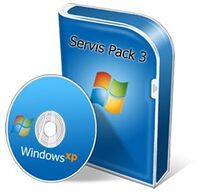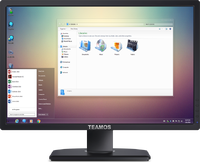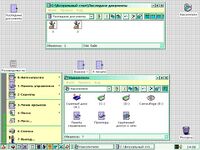CrustyWindows:About: Difference between revisions
(→History: todo: expand later) |
m (Elijah moved page Draft:Crusty Windows to Crusty Windows: this is as ready as its gonna get) |
Revision as of 22:45, 3 December 2023


Crusty Windows (also called bootleg Windows), known as говносборки (lit. "shit builds") in Russian, are illegally modified builds of the Microsoft Windows operating system. They are typically developed by eccentric individuals who wish to see their favorite OS and franchises collide or just want to include every driver and program in existence in their OS installs. Many of these bootlegs are severely unstable, barely install or function at all, have nonsensical themes and wallpapers, have barely any effort put into them whatsoever, are hysterically poorly made, or are just simply impossible to find because nobody in their right mind downloaded them.
Crusty Windows builds come in a wide variety of languages, most commonly in English, Arabic, Polish, Spanish, Chinese, and Russian. So far, at least one has been created in every continent (except Antarctica) - from the good ol' USA, to the exotic lands of the Great Wall, to the first traditional wonder of the ancient world, or even the land where maple syrup is consumed every day - there is always a Windows bootleg that represents someone out there.
While most bootlegs of Windows are free, a few cost money - for example, Lander X's bootlegs, and Radiant OS 11, which requires a TeamOS VIP subscription to download, which, funnily enough, is available for free here.
Sometimes, Crusty Windows builds can extend beyond simply being modifications of the Windows OS, as Linux-based mods such as YLMF OS 3.0 and Windows 12 Lite are known to exist.
History
The Beginning

The first bootleg that was created for Windows was a transformation pack called BedOS, released in early 2000. This OS required an existing install of Windows 95 or Windows 98 to function, and had releases in both Russian and English. It laid the foundations for many bootleg creators, as it added a custom theme, icons, and several additional drivers and programs, as well as removing some bloat from the existing install. It was a very important OS for kicking off the Russian bootleg scene and thus the Windows bootleg scene as a whole.
Several different versions of BedOS were released, including 2.0, 72214-1 (the first English version), and 3.0, themed after Mac OS X.
The name of the OS is a pun, as when romanized, the name would be "BadOS". It is also one of the very few bootlegs distributed as shareware.
The second earliest bootleg known to exist is one based on Windows XP before it was even released, known as Whistler Build 2531. Based on a Release Candidate 2 build of Windows XP, this bootleg also features many common changes of a bootleg, such as additional backgrounds, registry tweaks, cracked activation, and more. Hilariously, this ISO seems to have been created out of spite towards the beta scene of the time, who were known for hoarding betas and being picky about quality.
nLite Era
nLite is a tool for customizing Windows 2000, Windows XP or Windows Server 2003 installation media. It can do a variety of things, like integrating updates (and "addons"), like DriverPacks, Kels' CPL Bonus, the latest Windows update packs and security patches, Windows Media Player 11 and Internet Explorer 8, and more, preinstalling extra software via the setup hotfix feature, custom themes with the UXTheme patch, unattended installs (used to pre-activate the OS, and change the registration information), and even add in their own post-setup routines and drop custom files to certain locations. Because of its extensive feature set and ease of use, lots of modders use it to create the finishing bits of their creation, alongside editing the system files (and changing the image resources around) with Resource Hacker, and other important additions.
The early versions of nLite were first released sometime in October 2004, although it did not gain much traction until around 2005, when some early XP (including 2000, and 2003, to a lesser extent) bootlegs began to use the tool.
Examples of mods using nLite around this time are:
- Windows XP SP2 Bonzao Matrix (based on Windows XP SP2, nLite, June 14, 2005)
- Windows AlphaBetas (based on Windows 2000 SP4, nLite 1.0 beta 6 on Windows 2000, September 2005)
- TinyXP (based on Windows XP SP2, nLite 1.0 RC3 on Windows XP Professional SP2, late 2005)
- Wesmosis (ditto, nLite (unknown version), earliest releases go back to mid-late 2005, version in archive is mid-late 2007)
- Windows XP Gamer Edition (ditto, nLite 1.0 RC7, September 27, 2006)
As the tool became easier to use and ISOs became easier to distribute thanks to the rise of file sharing websites like MegaUpload and Rapidshare, nLite would see an explosive spike in usage around early 2008, as dozens of authors began using it to create their own Windows mods and share it with their favorite forums or friends.
The latest version of this program is 1.4.9.3, and can still be downloaded today. It has not been updated for more than a decade, as the creator has switched to making a tool named NTLite, which has the same purpose, but supports editing Windows 7, 8.x, 10 and 11.
Despite not being updated for more than 10 years, nLite has continued to be the most popular program for making Windows XP bootlegs. So many popular Windows XP bootlegs continued to be released into the mid 2010's and beyond, such as Gold Windows XP 2016, which got wide attention around the world. Even after support for Windows XP had ended, many popular Windows XP bootlegs still get released to this day.
vLite Era
vLite is a tool for customizing Windows Vista installations, designed as a successor to nLite. Much like nLite, it allows users to remove and add components, integrate updates, add registry tweaks, add custom themes, and more. The program also looks similar to nLite, although it has a more modern UI. Although not technically supported, vLite can also be used to customize Windows 7 RTM (but not SP1) installs, due to its similarities to Windows Vista.
vLite was first released in 2006, although most bootlegs that use it were released in 2008.
Some early examples of vLite being used are:
- TinyVista (vLite 1.2 beta on Windows Vista SP1, July 2008)
- Windows Vista Lite (vLite 1.1.6 on Windows XP SP3, January 14, 2009)
Quite a few notable Windows Vista bootlegs were made with vLite, such as:
- Windows Vista Kagome Titanium SP2 Edition (vLite 1.2 on Windows Vista Ultimate SP2, 2009)
- Windows Vista Alienware 2010 (vLite, April 20, 2010)
It has also been seen in a few Windows 7 RTM bootlegs, such as:
- Tiny7 (vLite 1.2 on Windows 7 RTM, August 31, 2009)
- Windows 7 Apple Logo (ditto, December 22, 2013)
As many users were unable to meet Windows Vista's demanding hardware requirements at the time, most users stuck to just making Windows XP bootlegs with the purpose of theming it to the Windows Vista style, with the help of the many customization utilities that were available around the time the Windows customization community was booming during Windows Vista's release. Therefore, vLite did not see nearly as much usage as its predecessor. It did not receive many updates and it was discontinued nearly five years before nLite.
The last version of vLite was 1.2 Final, and it can still be downloaded on Softpedia.
As with Windows XP, Vista bootlegs are still being made today, but they are much more rare and much, much less interesting and more questionable.
7Customizer/RT 7 Lite era
In the early days of Windows 7 bootlegging, many tools were created to modify Windows 7 installations, the two most famous ones being 7Customizer by blue4603 and RT 7 Lite by the Rockers International Team. Both tools were intended to replace the notably absent vLite and nLite, and allowed creators to slipstream updates, add and remove programs, add registry tweaks, add custom themes, and more, similar to the feature set of previous Windows installation media customizing solutions.
7Customizer was first released in October 2009, and is thus far more common in bootlegs created between 2009 and 2011, but bootlegs in the collection that were made with it remain to be seen, and yet to be catalogued in this wiki.
RT 7 Lite was released in late 2010, and as such many more notable and popular bootlegs were made with it, a unique example being Windows 7 FaceBooK Edition 2012.
The Present (NTLite)
NTLite was released in 2014, by the same person who created nLite and vLite. Much like those two, NTLite is a tool to customize Windows 7, 8.x, 10 and 11 installations. It was the first version to support multiple Windows versions. While vLite could edit Windows Vista and Windows 7 RTM, this was the first version of the series to officially support multiple Windows versions.
Many bootlegs still use NTLite today. Many alternatives to NTLite released too, like WinCustomizer and MSMG Toolkit. These are not as widely used as NTLite, though.